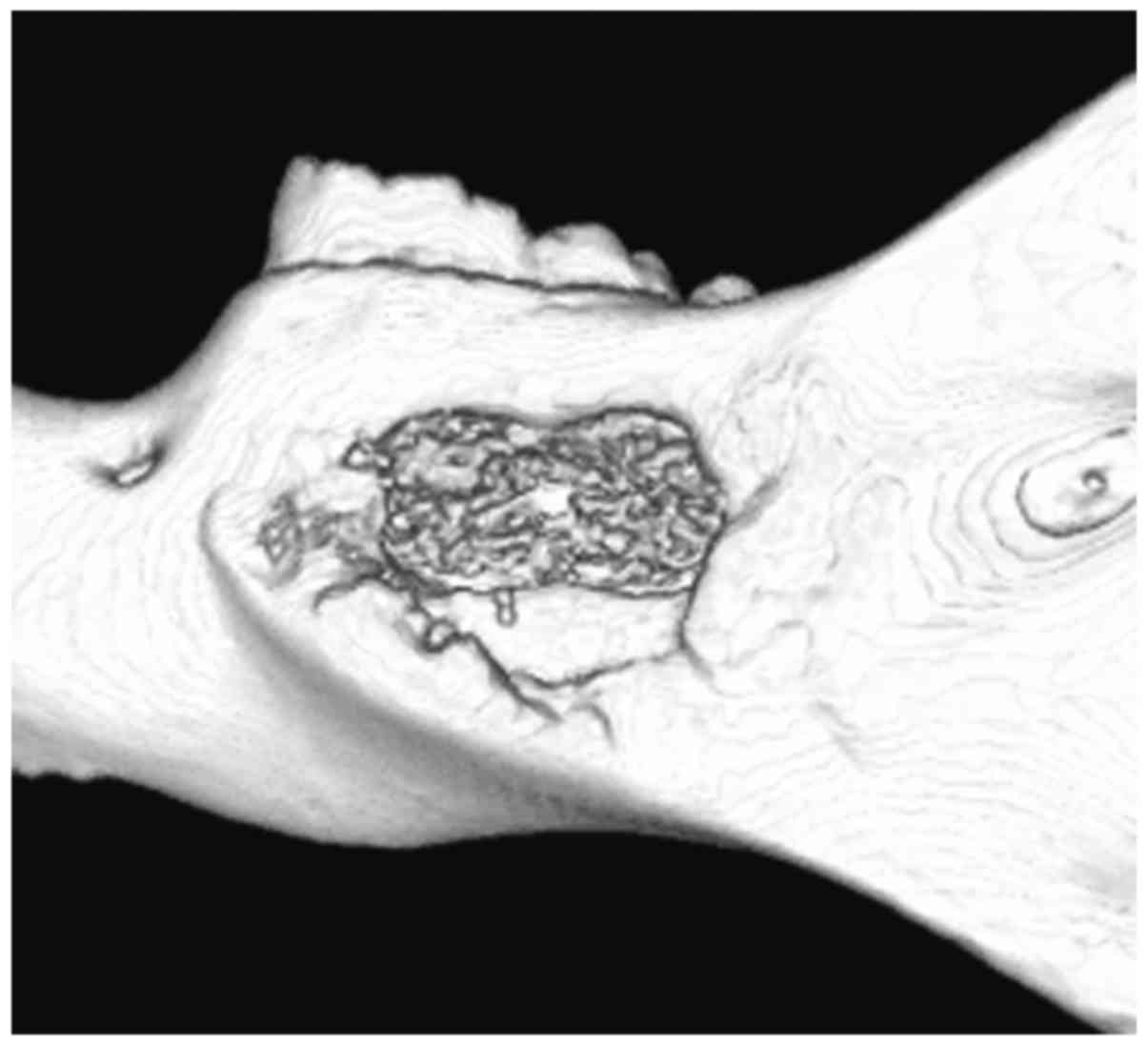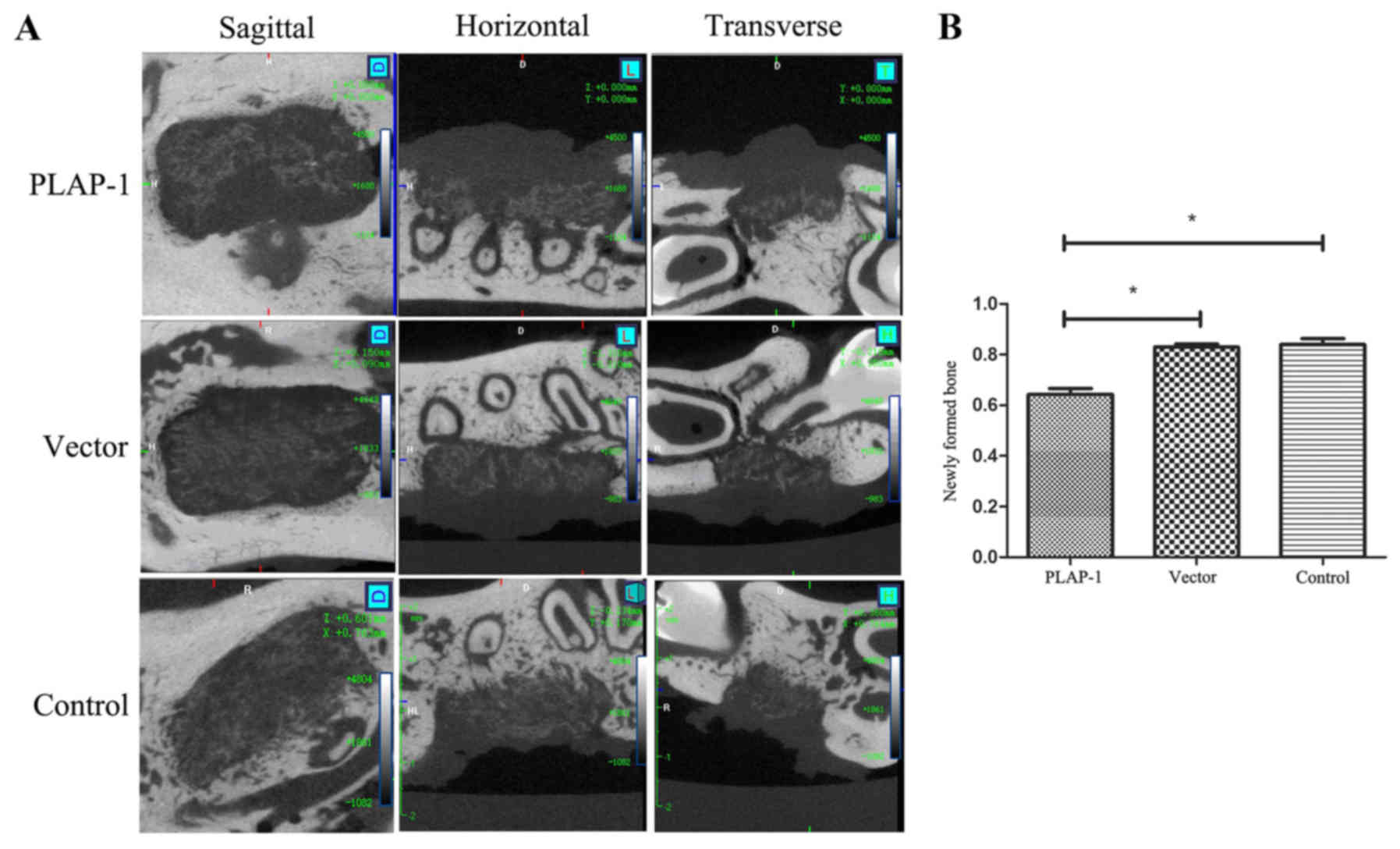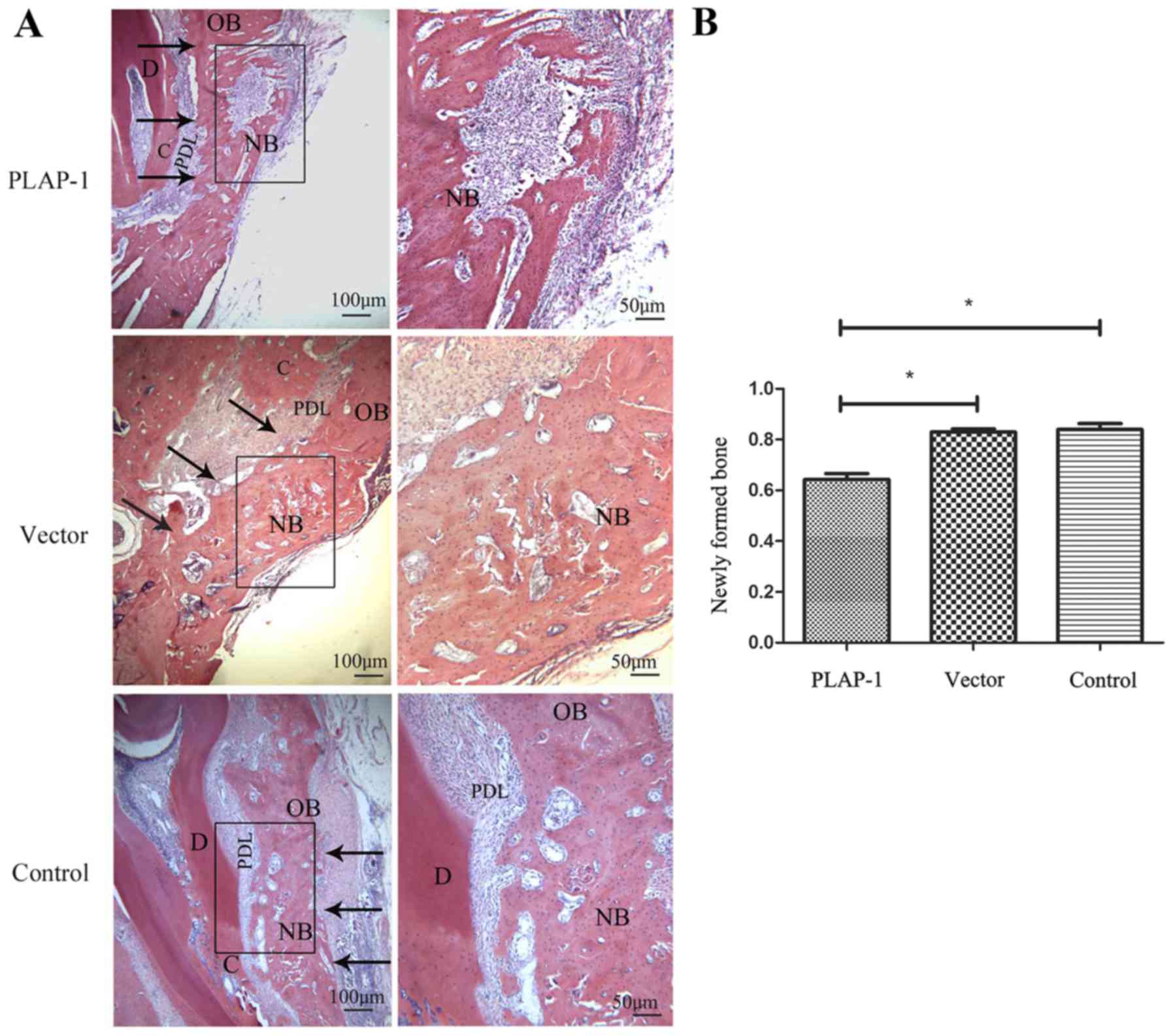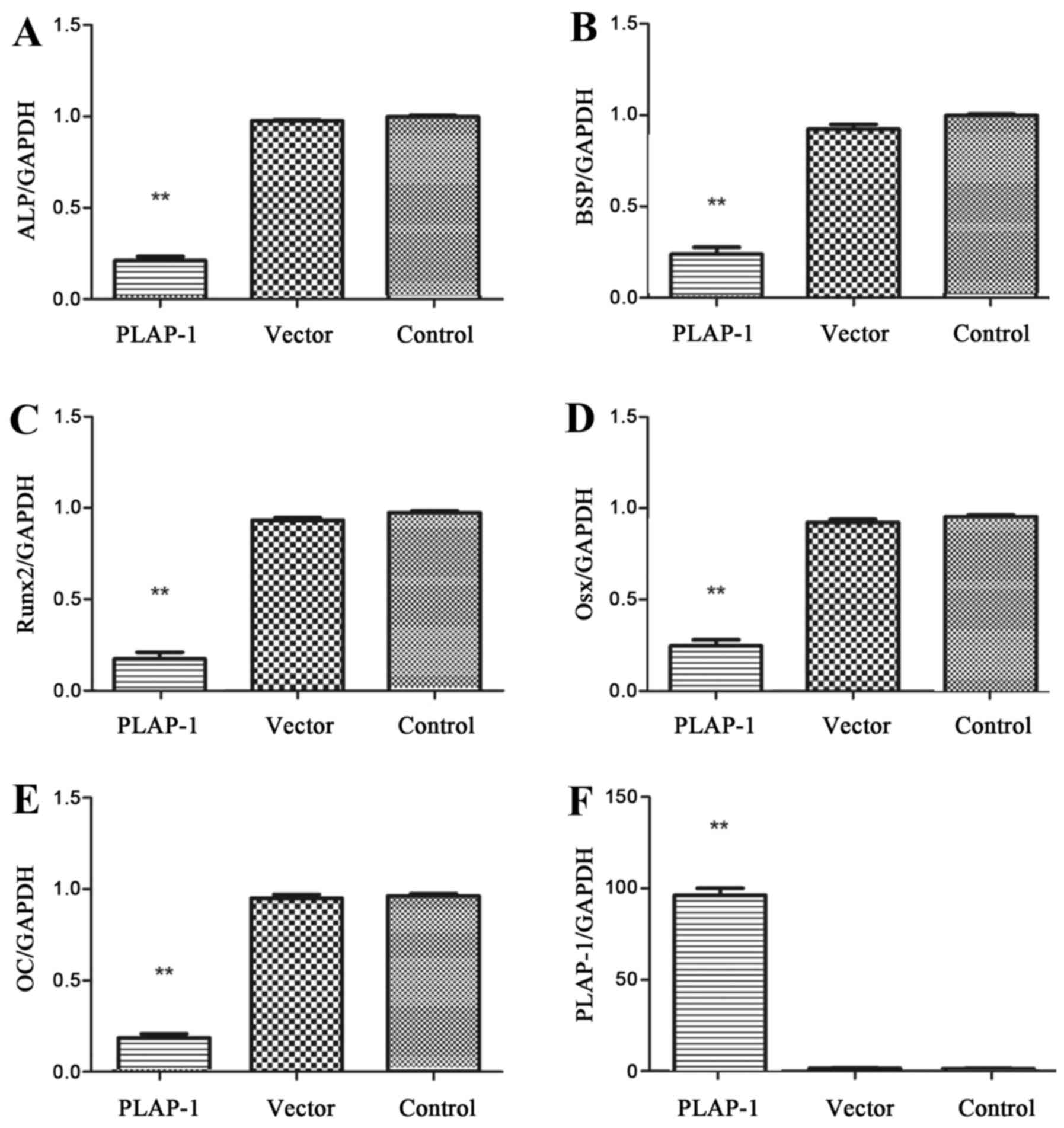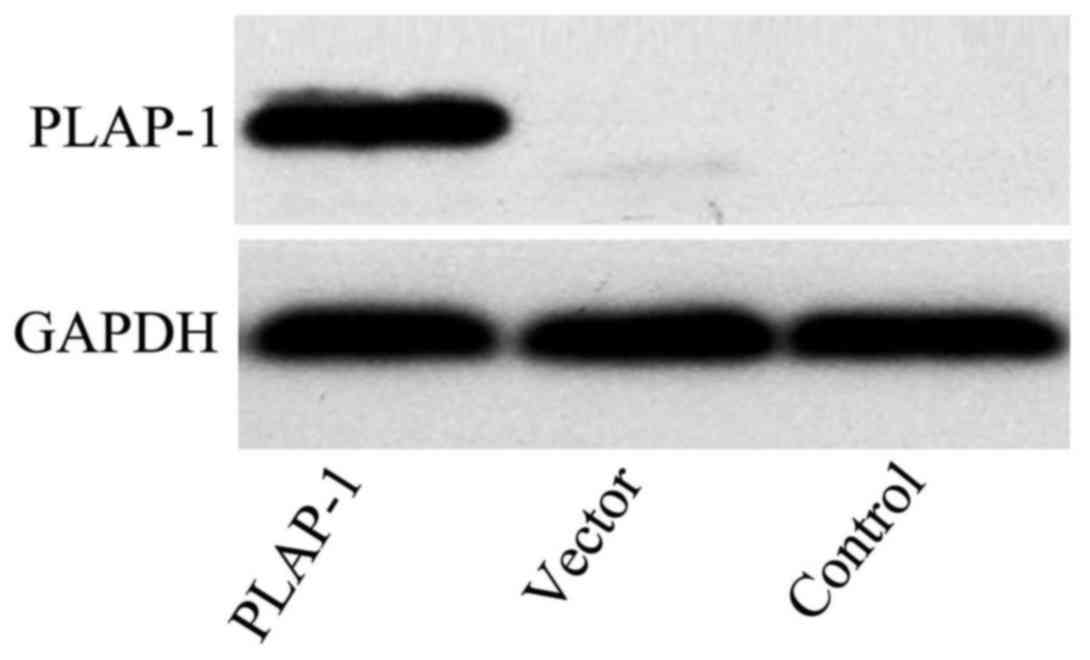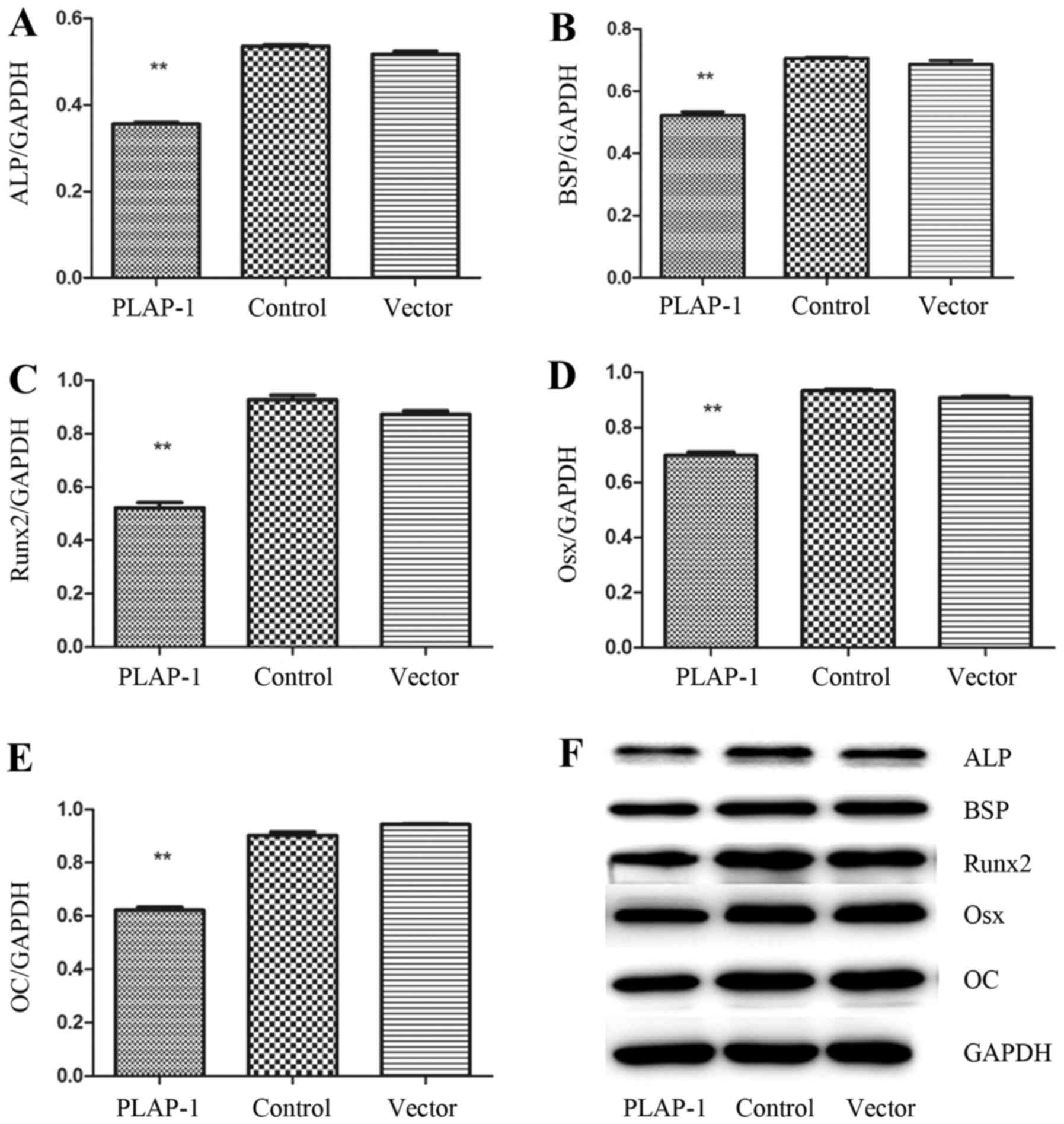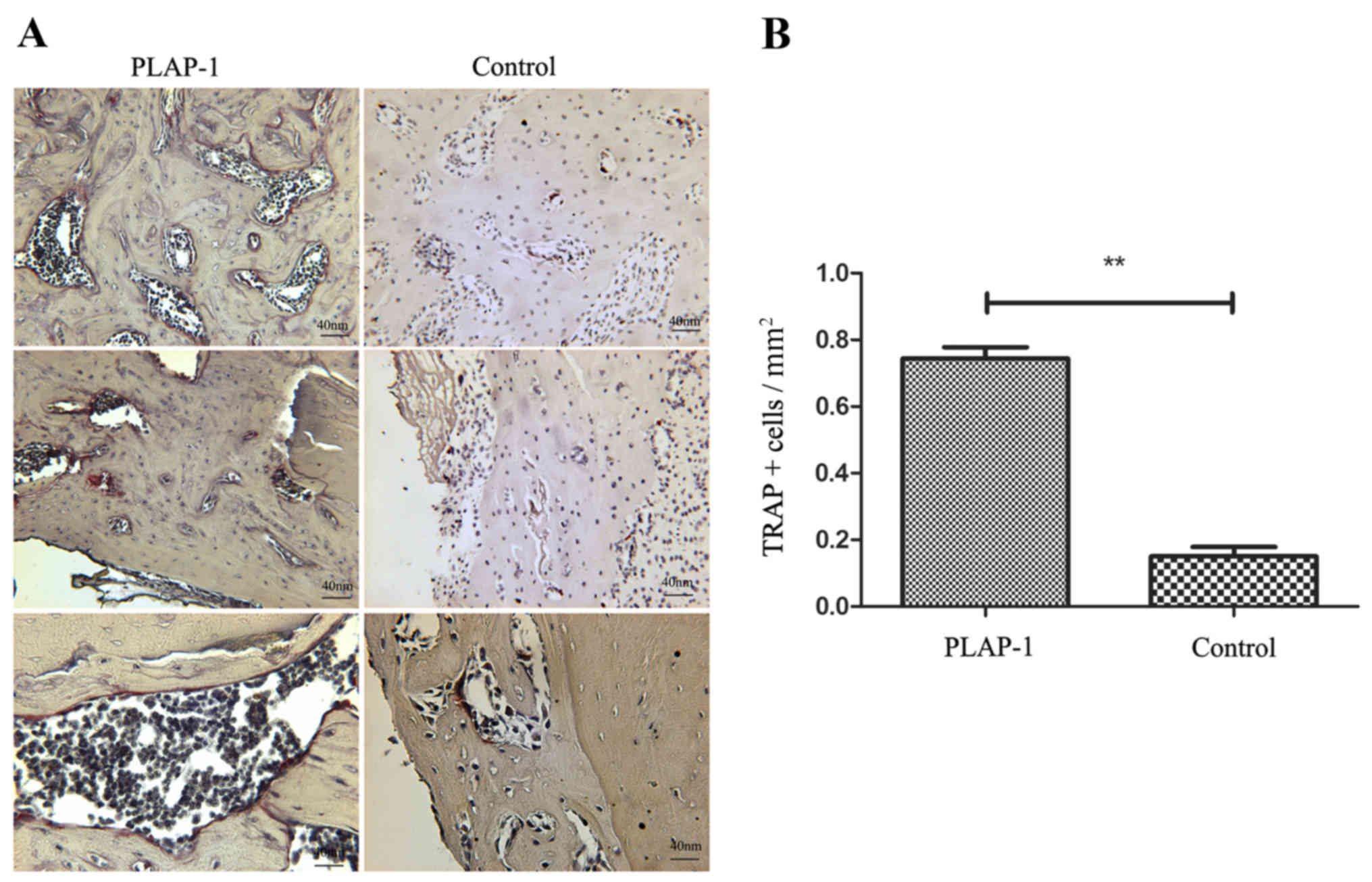Periodontal ligament‑associated protein‑1 delays rat periodontal bone defect repair by regulating osteogenic differentiation of bone marrow stromal cells and osteoclast activation
- Authors:
- Published online on: December 6, 2017 https://doi.org/10.3892/ijmm.2017.3312
- Pages: 1110-1118
Abstract
Introduction
As a member of the small leucine-rich repeat proteoglycan (SLRP) family (1,2), periodontal ligament-associated protein-1 (PLAP-1) plays an important role in maintaining the homeostasis of the periodontium (3,4), and protects the periodontal ligament from excessive osteogenesis by the negative regulation of the osteoblastic differentiation of periodontal fibroblasts (5) and periodontal ligament stem cells (PDLSCs) into mineralized tissue-forming cells (3,6).
Dental follicle stem cells (DFSCs) and PDLSCs are potentially able to differentiate into the periodontal lineage (7), and are therefore of value in dental tissue engineering (8). Bone marrow stromal cells (BMSCs) also have multilineage differentiation potential (9). Combined with biomaterials, BMSCs have been incorporated into repair different bone defects, including periodontal bone defects, in a number of studies (10–12). The majority of studies of tissue engineering have focused on osteogenesis-promoting factors, including osterix (Osx), bone morphogenetic protein-2 (BMP-2), alkaline phosphatase (ALP), osteocalcin (OC) and bone sialoprotein (BSP) (13–15), but our knowledge on osteogenesis-inhibiting factors, such as PLAP-1, and their molecular mechanisms is insufficient (16–18).
PLAP-1 is an important marker of the periodontal ligament. PDL cells have been demonstrated to be multipotent, with the microenvironment-dependent ability for differentiation into osteoblasts or cementoblasts. As a negative regulator, PLAP-1 inhibits periodontal ligament mineralization. To investigate the roles of PLAP-1 in the cytodifferentiation and mineralization of BMSCs, rat BMSCs overexpressing PLAP-1 were established in our previous study. The vector expressing the PLAP-1 gene was transfected into BMSCs and stable transfectants that were overexpressing PLAP-1 were established (19). The study showed that the overexpression of the PLAP-1 gene inhibits the differentiation of rat BMSCs (rBMSCs) into osteoblast-like cells in vitro (19) and delays rat critical-size skull defect repair in vivo (18). However, the molecular mechanisms of PLAP-1 in the osteogenic differentiation of BMSCs and in osteoclast activation in periodontal bone defect repair remain unclear.
Osteoblasts are vital for bone formation and for the maintenance of a dynamic equilibrium within bone tissues. RANKL/RANK signaling regulates osteoclast differentiation and activation in bone modeling and remodeling (20–22). OPG confers a protective effect over bone, preventing excessive resorption by binding to RANKL and impeding it from binding to RANK. Therefore, the OPG/RANKL ratio is a fundamental determinant in bone (23).
In the present study, osteogenesis-associated proteins, including ALP, BSP, runt-related transcription factor 2 (Runx2), Osx and OC, as indicators of rBMSC-induced osteogenesis (22), were examined to assess the role of PLAP-1 in the osteogenic differentiation of BMSCs. Osteoclast number and the RANKL/OPG ratio were quantified to analyze osteoclast activation. PLAP-1 is an important marker of the periodontal ligament (24) and studying its mechanism of action in the osteogenic differentiation of BMSCs and in osteoclast activation may assist in furthering dental tissue engineering (25).
Materials and methods
Animals
Male, 6-week-old, Wistar rats (n= 24; weight, 260–300 g; Laboratory Animal Center, Shandong University, Shandong, China), which were acclimated for 1 week prior to the experiments, were maintained on a normal hard food diet, with water ad libitum. The animals were housed in cage racks, with a 12-h light/12-h dark cycle (light on from 8:00 AM to 8:00 PM) at ambient temperature (22–24°C) and 45% relative humidity. Experiments used in this study were conducted according to the guidelines for Animal Experimentation of Shandong University. The study was approved by the Ethics Committee of the School of Stomatology, Shandong University. Rats that received a periodontal bone defect of 5×2×1 mm according to a previously described procedure (26) were randomly allocated to 3 groups according to differentially transfected-rBMSCs: PLAP-1 group (collagen membranes with PLAP-1 lentivirus-transfected rBMSC were transferred to the periodontal bone defects), vector group (collagen membranes with empty vector lentivirus-transfected rBMSC were transferred to the periodontal bone defects) and control group (collagen membranes with normal rBMSC were transferred to the periodontal bone defects). For statistical analysis, 8 animals were present in each group.
Cell culture
Primary rBMSCs were harvested from 4-week-old Wistar rats as previously described (9). Briefly, the proximal end of the femora and the distal end of the tibiae were excised. α-minimal essential medium (α-MEM; Gibco, Grand Island, NY, USA), supplemented with 20% fetal bovine serum (FBS; Gibco), 200 IU/ml penicillin and 200 mg/ml streptomycin (Solarbio, Beijing, China) was used to flush the marrow gently from the shafts with a 25-gauge needle. A single-cell suspension was obtained by gently aspirating the cells sequentially through 20- and 23-gauge needles. The bone marrow cells were then seeded into culture flasks (Takara Bio, Inc., Otsu, Japan) at a cell density of 4.0×105 cells/cm2 and cultured using α-MEM supplemented with 10% fetal bovine serum (FBS), 100 IU/ml penicillin and 100 mg/ml streptomycin. The culture medium was changed every 3 days, and the cells were subcultured 1:3 at subconfluence. The adherent cells after one subculture were termed rBMSCs. Cells (3-5 passages) were subsequently used for experiments.
Overexpression of the PLAP-1 gene in rBMSCs
The protocol of overexpression of the PLAP-1 gene in rBMSCs was the same as previously described (18,27). rBMSCs were then plated in 6-well plates (1×105 cells⁄well) and transfected with viral stocks of pPBABE-hygro-PLAP-1, pPBABE-hygro or empty vector in the presence of polybrene (6 µg⁄ml; Sigma-Aldrich; Merck KGaA, Darmstadt, Germany) for 8 h. At 24 h post-transfection, the rBMSCs were subjected to hygromycin B selection (50 µg⁄ml) for 2 weeks. The stably transduced rBMSCs were used for the following experiments.
Cell seeding
Type I collagen membranes (Sigma-Aldrich; Merck KGaA) were trimmed into 5×2×1-mm pieces and sterilized for usage as previously described (21). The differentially transfected-rBMSCs (1×104) were suspended in 5-µl α-MEM, seeded on each surface of the collagen scaffolds and cultured for 3 h in the incubator in 5% CO2 at 37°C. After anesthetization by intraperitoneal injection of 10% chloral hydrate (0.4 g/kg body weight), Bilateral bone defects were created at the buccal aspect of the mandibular molar. The signs of peritonitis were not observed following the administration of 10% chloral hydrate. A defect of 5×2×1 mm was made in the mandibular body using a dental drill driven at a low speed with irrigation of 0.9% sodium chloride. Type I collagen membranes and differentially transfected-rBMSCs were applied to fill in the defect. The wounds were closed with nylon 4-0 sutures.
Tissue preparation
The rats were euthanized in order to minimize pain and distress. The rats were sacrificed at 2, 4 and 6 weeks post-surgery. Anesthetized by intraperitoneal injection of 10% chloral hydrate (0.4 g/kg body weight), the rats were fixed with 4% paraformaldehyde (PFA) via systemic circulation fixation for 30 min, and then the detached mandible was further fixed immediately in 4% PFA for another 12 h at 4°C. The specimens were then demineralized in 10% EDTA for 3 months. The demineralized tissues were dehydrated by gradient ethanol, cleared with xylene and embedded in paraffin. Serial sections of 5 µm in thickness were sliced in the buccolingual direction. The specimens of mandibular bone for the western blotting and RT-qPCR analyses were not fixed. The defect areas were cut from the mandibular bone with 1-mm margins using bone cutting forceps and then rapidly frozen in liquid nitrogen and stored at −80°C.
Micro-computed tomography (micro-CT) imaging and analysis
For analysis of the alveolar bone loss, fixed mandible samples were scanned using a PerkinElmer micro-CT (PerkinElmer, Inc., Waltham, MA, USA) at 90 kV and 88 µA. All scans were reoriented prior to analysis to uniformly align the scan axes and anatomical positions. The specimens were scanned at a resolution of 10 µm, ensuring that the defect areas were encompassed. The three-dimensional (3D) volume viewer and analyzer software (Analyze 12.0 and SimpleViewer version 5.1.2; PerkinElmer, Inc.) were used for the visualization and quantification of two-dimensional (2D) and 3D data on a personal computer output and a standardized gray scale value was used to visualize only mineralized tissues.
RT-PCR
Total RNA was extracted from the cells and bone defect tissues with RNAiso Plus (Takara Bio, Inc.) according to the manufacturer's instructions. A total of 1.0 mg RNA (in a 20-ml reaction volume) was reverse transcribed using the PrimeScript RT Reagent kit with gDNA Eraser (Takara Bio, Inc.). RT-PCR amplifications labeled with SYBR Premix Ex Taq (Takara Bio, Inc.) were performed in a Roche LightCycler 480 (Roche Diagnostics GmbH, Mannheim, Germany) at 95°C for 30 sec, then at 95°C for 5 sec and 60°C for 30 sec for a total of 40 cycles. The primer sequences for PLAP-1, ALP, BSP, Runx2, Osx and OC (19) were designed with Primer-BLAST software from the National Center for Biotechnology Information (Bethesda, MD, USA) nucleotide sequence database (Table I). Relative expression was normalized to GAPDH using the 2−∆∆Cq method (28).
Western blotting
The frozen samples were homogenized with hypotonic lysis buffer (Solarbio). Protein concentrations were determined by bicinchoninic acid protein assay kit (Beyotime Institute of Biotechnology, Jiangsu, China), and the curves in the BSA protein standard curves were used. Equal amounts of total proteins (20 µg per lane) were resolved by 10% SDS-polyacrylamide gel electrophoresis and transferred to polyvinylidene difluoride membranes (Invitrogen; Thermo Fisher Scientific, Inc., Waltham, MA, USA). The membranes was washed three times and blocked with 5% skimmed milk (BD, Mr Ng Nanjing Biological, Nanjing, China) at room temperature for 1 h. Next, the membranes were incubated with antibodies against PLAP-1 (diluted 1:1,000; A3883-45C-AP; US Biological, Salem, MA, USA), ALP (diluted 1:1,000; ab95462), BSP (diluted 1:1,000; ab52128), Runx2 (diluted 1:1,000; ab23981), Osx (diluted 1:1,000; ab209484), OC (diluted 1:1,000; ab13420) (all Abcam, Cambridge, MA, USA), OPG (diluted 1:500; bs-0431R) or RANKL (diluted 1:500; bs-0747R) (both Bioss, Beijing, China) overnight at 4°C. Secondary antibodies, horseradish peroxidase-linked goat anti-rabbit IgG (diluted 1:5,000; CW0156S; CW Biotech, Beijing, China), were then applied. The blots were visualized using enhanced chemiluminescence reagents (EMD Millipore, Billerica, MA, USA), and quantified by densitometric analysis [ImageJ (×64); 1.48u; National Institutes of Health, Bethesda, MD, USA]. Equal protein loading was shown by stripping and incubation with an anti-GAPDH antibody (diluted 1:5,000; CW0100S; CW Biotech).
Tartrate-resistant acid phosphatase (TRAP) staining
Sections were deparaffinized using xylene, hydrated in gradient ethanols and gently washed twice with prewarmed, filtered water (37°C). The sections were then fixed with stationary liquid for 20 sec and stained with TRAP (Sigma-Aldrich; Merck KGaA) for 60 min at 37°C. The TRAP-stained cells were then counterstained with hematoxylin (Solarbio) at room temperature for 5 min, and examined under a light microscope. TRAP+ multinucleated cells containing three or more nuclei were counted as osteoclasts. Osteoclasts were quantified by imaging five fields of view under 100-fold magnification and directly counting the number of TRAP+ cells.
Statistical analysis
Statistically significant differences (P<0.05) between the various groups were measured using one-way analysis of variance and Student-Newman-Keuls test. All statistical analyses were performed using the SPSS 17.0 statistical software package (SPSS, Inc., Chicago, IL, USA). All data are expressed as the mean ± standard deviation.
Results
Micro-CT images
Newly formed mineralized bone could be found in the defects at 4 weeks post-surgery (Fig. 1). The newly formed mineralized bone showed a trabecular structure. The mineralization density of the new bone was lower than that of normal bone (Fig. 2A). The new mineralized bone in the control and vector groups was significantly greater in quantity than that in the PLAP-1 group (P<0.05). There was no significant difference in the amount of newly formed bone between the vector and control groups (Fig. 2B).
Histological observation
Histological observation showed that newly formed bone had filled the majority of the defects of the PLAP-1 group at 6 weeks post-surgery. Newly formed bone trabeculae and lacunae were visible in the new bone. Osteoblasts, multinucleated osteoclasts and bone resorption pits could be viewed, which indicated that osteogenesis and bone resorption occurred simultaneously in the PLAP-1 group.
In the vector and control groups, newly formed bones had almost filled the defects, but there were a lot of bone lacunae at the new bone area. Osteoblasts could be observed at the edge of the new bone. Few osteoclasts could be found in the two groups (Fig. 3A). The newly formed bone proportion was analyzed using Image-Pro Plus 6.0 (Media Cybernetics, Silver Spring, MD, USA). The amount of new bone in the PLAP-1 group was significantly less than that in the vector and control groups (P<0.05). There was no significant difference in the amount of newly formed bone between the vector and control groups (Fig. 3B).
RT-qPCR
The mRNA expression of osteogenesis-associated proteins in rat periodontal bone defects at 4 weeks post-surgery was detected using RT-PCR. ALP, BSP, Runx2, Osx and OC mRNA expression was deceased in the PLAP-1 group compared with that in the vector and control groups (Fig. 4A–E) (P<0.01).
PLAP-1 expression in rBMSCs was elevated significantly following transfection with pPBABE-hygro-PLAP-1 compared with that in rBMSCs transfected with empty vector and normal rBMSCs (Figs. 4F and 5).
Western blotting
The expression of ALP, BSP, Runx2, Osx and OC in rat periodontal bone defects at 4 weeks post-surgery was also detected using western blotting. ALP, BSP, Runx2, Osx and OC expression was deceased in the PLAP-1 group compared with that in the vector and control groups (P<0.01) (Fig. 6A–F), which was similar to the mRNA expression results. Expression of RANKL and OPG protein in rat periodontal bone defects at 2, 4 and 6 weeks was detected by western blotting. RANKL protein expression was upregulated during rat periodontal bone defect repair, and higher expression was observed in the PLAP-1 group compared with the control group (Fig. 7A). This trend was reversed for OPG; OPG was downregulated compared with the higher expression of the control group from 2 to 6 weeks (Fig. 7B). The RANKL/OPG ratio was upregulated in the PLAP-1 group compared with that in the control group (P<0.01) (Fig. 7C and D).
TRAP staining
TRAP staining of the periodontal defects was applied at 6 weeks. TRAP is highly expressed by osteoclasts, which reflects osteoclast activity. A number of TRAP+ multi-nucleated cells were found in the PLAP-1 group. By contrast, TRAP+ cells were hardly detectable at 6 weeks in the control group (Fig. 8A). The number of TRAP+ cells in the periodontal defects of the PLAP-1 group was significantly higher than that in the control group (P<0.01) (Fig. 8B).
Discussion
It is widely known that clinical periodontal tissue regeneration in patients with serious periodontitis is difficult to achieve (29). Besides the conventional approach of anti-inflammatory therapy, dental tissue engineering has been used to obtain periodontal tissue regeneration. Seeding cells, including DFSCs, PDLSCs and BMSCs, have been incorporated into the repair of periodontal bone defects (30). BMSCs have a multilineage differentiation potential, highly proliferative capacity and the ability to differentiate into several cell lineages, including muscle, bone, cartilage, epithelium, fat and neural progenitors (31,32). BMSCs have been applied in studies associated with osteoblast differentiation and bone regeneration. In the present study, rBMSCs were applied as a cellular model to investigate the functions of PLAP-1 in osteoblast differentiation and osteoclast activation.
According to histological observations and micro-CT examinations, PLAP-1 inhibited rat periodontal defect repair. The formation and mineralization of new bone was less prominent in the PLAP-1 group. The suppression of PLAP-1 would therefore be useful for periodontal bone formation and regeneration. Hence, a better understanding of the cellular and molecular mechanisms behind the function of PLAP-1 is vital.
Osteoblast markers are well documented to primarily include ALP, BSP, Runx2, Osx and OC. By observing the levels of osteoblast markers, osteoblast differentiation from rBMSCs can be speculated upon. The present RT-PCR and western blotting results showed that PLAP-1 reduced the expression levels of these markers at 4 weeks post-surgery compared with that in the vector and normal groups; the osteogenic differentiation of rBMSCs was restrained in vivo. The same effects in osteoblast differentiation have been reported (19). PLAP-1 regulates periodontal ligament cell cytodifferentiation and mineralization through BMP-2 activity. PLAP-1 inhibits the effect of BMP by binding to BMP receptor, which indicates that PLAP-1 forms part of the negative feedback mechanism of BMP-2 (33).
Osteoclast formation, activation and survival is regulated in normal bone modeling and remodeling by RANKL/RANK signaling. Osteoclast number and activity can increase if there is a change in the RANKL/OPG ratio (34). During the progression of rat periodontal bone defect repair, osteoclast precursors are attracted from the invading blood vessels close to newly formed bone trabeculae. Multinucleated osteoclasts are formed by the fusion of these precursors with each other, and the osteoclasts then resorb the majority of the newly formed bone, leaving only a limited number of trabeculae. The osteoblasts lay down new bone on certain surface regions of the surviving trabeculae where there had previously been osteoclastic resorption and a great deal of this new bone is then resorbed by osteoclasts in a remodeling process (35,36).
As aforementioned, there was no significant difference between the vector and control groups in the present study. So only the PLAP-1 and control groups were included in the following experiments. RANKL and OPG expression in bone defect tissues was detected at 2, 4 and 6 weeks during rat periodontal bone defect repair. Higher RANKL/OPG ratio expression was observed in the PLAP-1 group, that is, the PLAP-1 gene in the BMSCs led to an increase in the RANKL/OPG ratio, which was further confirmed by TRAP staining. A greater number of TRAP+ cells was observed in the PLAP-1 group than in the control group even at the late stage of defect repair. An extensive bone remodeling process was observed in the PLAP-1 group. Overexpression of PLAP-1 promoted osteoclast activation dependent on the upregulated RANKL/OPG ratio.
Taken together, the present results showed that PLAP-1 suppressed the differentiation of rBMSCs into osteoblasts and promoted osteoclast activation in the rat periodontal bone defects model. PLAP-1 exhibited positive effects on bone remodeling by promoting osteoclastogenesis and reducing osteoblast differentiation, leading to an inhibited repair effect.
The molecular mechanism of PLAP-1 in osteoblast differentiation, osteoclastogenesis and bone remolding require further investigation to promote bone functional regeneration. It is of great importance to reveal the negative feedback regulation between PLAP-1 and positive growth factors in mineralized tissues under physiological and pathological conditions.
Acknowledgments
This study was supported by the National Natural Science Foundation of China (grant no. 81271138), the Open Foundation of Shandong Provincial Key Laboratory of Oral Biomedicine (grant no. SDKQ201403) and the Shandong Province Natural Science Foundation (grant no. ZR2015PH017).
References
|
Nakajima M, Kizawa H, Saitoh M, Kou I, Miyazono K and Ikegawa S: Mechanisms for asporin function and regulation in articular cartilage. J Biol Chem. 282:32185–32192. 2007. View Article : Google Scholar : PubMed/NCBI | |
|
Ueda M, Goto T, Kuroishi KN, Gunjigake KK, Ikeda E, Kataoka S, Nakatomi M, Toyono T, Seta Y and Kawamoto T: Asporin in compressed periodontal ligament cells inhibits bone formation. Arch Oral Biol. 62:86–92. 2016. View Article : Google Scholar | |
|
Yamada S, Ozawa Y, Tomoeda M, Matoba R, Matsubara K and Murakami S: Regulation of PLAP-1 expression in periodontal ligament cells. J Dent Res. 85:447–451. 2006. View Article : Google Scholar : PubMed/NCBI | |
|
Yamada S, Kitamura M and Murakami S: PLAP-1: a novel molecule regulating homeostasis of periodontal tissues. Jpn Dent Sci Rev. 44:137–144. 2008. View Article : Google Scholar | |
|
Chen YC, Ninomiya T, Hosoya A, Hiraga T, Miyazawa H and Nakamura H: 1α,25-Dihydroxyvitamin D3 inhibits osteoblastic differentiation of mouse periodontal fibroblasts. Arch Oral Biol. 57:453–459. 2012. View Article : Google Scholar | |
|
Kajikawa T, Yamada S, Tauchi T, Awata T, Yamaba S, Fujihara C and Murakami S: Inhibitory effects of PLAP-1/asporin on periodontal ligament cells. J Dent Res. 93:400–405. 2014. View Article : Google Scholar : PubMed/NCBI | |
|
Sowmya S, Chennazhi KP, Arzate H, Jayachandran P, Nair SV and Jayakumar R: Periodontal specific differentiation of dental follicle stem cells into osteoblast, fibroblast, and cementoblast. Tissue Eng Part C Methods. 21:1044–1058. 2015. View Article : Google Scholar : PubMed/NCBI | |
|
Ivanovski S, Vaquette C, Gronthos S, Hutmacher DW and Bartold PM: Multiphasic scaffolds for periodontal tissue engineering. J Dent Res. 93:1212–1221. 2014. View Article : Google Scholar : PubMed/NCBI | |
|
Li S, Tu Q, Zhang J, Stein G, Lian J, Yang PS and Chen J: Systemically transplanted bone marrow stromal cells contributing to bone tissue regeneration. J Cell Physiol. 215:204–209. 2008. View Article : Google Scholar | |
|
Pittenger MF, Mackay AM, Beck SC, Jaiswal RK, Douglas R, Mosca JD, Moorman MA, Simonetti DW, Craig S and Marshak DR: Multilineage potential of adult human mesenchymal stem cells. Science. 284:143–147. 1999. View Article : Google Scholar : PubMed/NCBI | |
|
Kramer PR, Nares S, Kramer SF, Grogan D and Kaiser M: Mesenchymal stem cells acquire characteristics of cells in the periodontal ligament in vitro. J Dent Res. 83:27–34. 2004. View Article : Google Scholar | |
|
Nivedhitha Sundaram M, Sowmya S, Deepthi S, Bumgardener JD and Jayakumar R: Bilayered construct for simultaneous regeneration of alveolar bone and periodontal ligament. J Biomed Mater Res B Appl Biomater. 104:761–770. 2016. View Article : Google Scholar | |
|
Ohyama Y, Nifuji A, Maeda Y, Amagasa T and Noda M: Spacio-temporal association and bone morphogenetic protein regulation of sclerostin and osterix expression during embryonic osteogenesis. Endocrinology. 145:4685–4692. 2004. View Article : Google Scholar : PubMed/NCBI | |
|
Parker AM and Katz AJ: Adipose-derived stem cells for the regeneration of damaged tissues. Expert Opin Biol Ther. 6:567–578. 2006. View Article : Google Scholar : PubMed/NCBI | |
|
Tu Q, Zhang J, Paz J, Wade K, Yang P and Chen J: Haplo-insufficiency of Runx2 results in bone formation decrease and different BSP expression pattern changes in two transgenic mouse models. Cell Physiol. 217:40–47. 2008. View Article : Google Scholar | |
|
Ikegawa S: Expression, regulation and function of asporin, a susceptibility gene in common bone and joint diseases. Curr Med Chem. 15:724–728. 2008. View Article : Google Scholar : PubMed/NCBI | |
|
Kou I, Nakajima M and Ikegawa S: Expression and regulation of the osteoarthritis-associated protein asporin. J Biol Chem. 282:32193–32199. 2007. View Article : Google Scholar : PubMed/NCBI | |
|
Yu X, Sun J, Hu Y, Gao Y, Xiao C, Liu S and Li S: Overexpression of PLAP-1 in bone marrow stromal cells inhibits the rat critical-size skull defect repair. J Mol Histol. 46:251–261. 2015. View Article : Google Scholar : PubMed/NCBI | |
|
Sun J, Zhang T, Zhang P, Lv L, Wang Y, Zhang J and Li S: Overexpression of the PLAP-1 gene inhibits the differentiation of BMSCs into osteoblast-like cells. J Mol Histol. 45:599–608. 2014. View Article : Google Scholar : PubMed/NCBI | |
|
Boyce BF and Xing L: Functions of RANKL/RANK/OPG in bone modeling and remodeling. Arch Biochem Biophys. 473:139–146. 2008. View Article : Google Scholar : PubMed/NCBI | |
|
Yu X, Lv L, Zhang J, Zhang T, Xiao C and Li S: Expression of neuropeptides and bone remodeling-related factors during periodontal tissue regeneration in denervated rats. J Mol Histol. 46:195–203. 2015. View Article : Google Scholar : PubMed/NCBI | |
|
Theoleyre S, Wittrant Y, Tat SK, Fortun Y, Redini F and Heymann D: The molecular triad OPG/RANK/RANKL: Involvement in the orchestration of pathophysiological bone remodeling. Cytokine Growth Factor Rev. 15:457–475. 2004. View Article : Google Scholar : PubMed/NCBI | |
|
Tu Q, Valverde P and Chen J: Osterix enhances proliferation and osteogenic potential of bone marrow stromal cells. Biochem Biophys Res Commun. 341:1257–1265. 2006. View Article : Google Scholar : PubMed/NCBI | |
|
Tomoeda M, Yamada S, Shirai H, Ozawa Y, Yanagita M and Murakami S: PLAP-1/asporin inhibits activation of BMP receptor via its leucine-rich repeat motif. Biochem Biophys Res Commun. 371:191–196. 2008. View Article : Google Scholar : PubMed/NCBI | |
|
Awata T, Yamada S, Tsushima K, Sakashita H, Yamaba S, Kajikawa T, Yamashita M, Takedachi M, Yanagita M, Kitamura M, et al: PLAP-1/asporin positively regulates FGF-2 activity. J Dent Res. 94:1417–1424. 2015. View Article : Google Scholar : PubMed/NCBI | |
|
Lv L, Wang Y, Zhang J, Zhang T and Li S: Healing of periodontal defects and calcitonin gene related peptide expression following inferior alveolar nerve transection in rats. J Mol Histol. 45:311–320. 2014. View Article : Google Scholar | |
|
Zhang PP, Li S, Yang PS and Sun J: Construction and confirmation of a recombinant eukaryotic expression plasmid pBABe-hygro-PLAP-1. Shanghai Kou Qiang Yi Xue. 19:635–640. 2010.In Chinese. | |
|
Livak KJ and Schmittgen TD: Analysis of relative gene expression data using real-time quantitative PCR and the 2(−Delta DeltaC(T)) Method. Methods. 25:402–408. 2001. View Article : Google Scholar | |
|
Yamaba S, Yamada S, Kajikawa T, Awata T, Sakashita H, Tsushima K, Fujihara C, Yanagita M and Murakami S: PLAP-1/asporin regulates TLR2- and TLR4-induced inflammatory responses. J Dent Res. 94:1706–1714. 2015. View Article : Google Scholar : PubMed/NCBI | |
|
Liao W, Okada M, Sakamoto F, Okita N, Inami K, Nishiura A, Hashimoto Y and Matsumoto N: In vitro human periodontal ligament-like tissue formation with porous poly-L-lactide matrix. Mater Sci Eng C. 33:3273–3280. 2013. View Article : Google Scholar | |
|
Yamachika E, Tsujigiwa H, Matsubara M, Hirata Y, Kita K, Takabatake K, Mizukawa N, Kaneda Y, Nagatsuka H and Iida S: Basic fibroblast growth factor supports expansion of mouse compact bone-derived mesenchymal stem cells (MSCs) and regeneration of bone from MSC in vivo. J Mol Histol. 43:223–233. 2012. View Article : Google Scholar | |
|
Wu B, Ma X, Zhu D, Liu Y, Sun Z, Liu S, Xue B, Du M and Yin X: Lentiviral delivery of biglycan promotes proliferation and increases osteogenic potential of bone marrow-derived mesenchymal stem cells in vitro. J Mol Histol. 44:423–431. 2013. View Article : Google Scholar : PubMed/NCBI | |
|
Yamada S, Tomoeda M, Ozawa Y, Yoneda S, Terashima Y, Ikezawa K, Ikegawa S, Saito M, Toyosawa S and Murakami S: PLAP-1/asporin, a novel negative regulator of periodontal ligament mineralization. J Biol Chem. 282:23070–23080. 2007. View Article : Google Scholar : PubMed/NCBI | |
|
Yu XJ, Xiao CJ, Du YM, Liu S, Du Y and Li S: Effect of hypoxia on the expression of RANKL/OPG in human periodontal ligament cells in vitro. Int J Clin Exp Pathol. 8:12929–12935. 2015. | |
|
Yu X, Botchwey EA, Levine EM, Pollack SR and Laurencin CT: Bioreactor-based bone tissue engineering: the influence of dynamic flow on osteoblast phenotypic expression and matrix mineralization. Proc Natl Acad Sci USA. 101:11203–11208. 2004. View Article : Google Scholar : PubMed/NCBI | |
|
Li M, Hasegawa T, Hogo H, Tatsumi S, Liu Z, Guo Y, Sasaki M, Tabata C, Yamamoto T, Ikeda K, et al: Histological examination on osteoblastic activities in the alveolar bone of transgenic mice with induced ablation of osteocytes. Histol Histopathol. 28:327–335. 2013.PubMed/NCBI |



